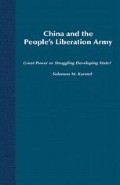Abstract
People’s War” is dead, and “People’s War under Modern Conditions” is an essentially misleading and meaningless appellation for China’s struggle toward very new strategic directions. Yet the emphasis is on the word “struggle.” China’s leadership is burning a Maoist bridge behind it without a secure replacement.
Access this chapter
Tax calculation will be finalised at checkout
Purchases are for personal use only
Preview
Unable to display preview. Download preview PDF.
Notes
Harlan Jencks, “Ground Forces,” in Gerald Segal and William T. Tow, eds., Chinese Defense Policy ( London: Macmillan Press, 1984 ), pp. 65–66.
Rosita Dellios, Modern Chinese Defense Strategy ( Houndsmills, UK: MacMillan, 1989 ), p. 1.
Kenneth W. Allen, Glenn Krumel, and Jonathan D. Pollack, China’s Air Force Enters the 21st Century ( Santa Monica, CA: RAND, 1995 ), pp. 22–23.
June Teufel Dreyer, “The Role of the Armed Forces in Contemporary China,” in Edward A. Olsen and Stephen Jurika, Jr., eds., The Armed Forces in Contemporary Asian Societies ( Boulder, CO: Westview Press, 1986 ), p. 37.
Mel Gurtov and Byong-Moo Hwang, China’s Security: The New Roles of the Military ( Boulder, CO: Lynne Reinner, 1998 ).
Deng Liqun et. al., eds., The Chinese People’s Liberation Army, Vol. I ( Beijing: Contemporary China Publishing House, 1994 ), pp. 582–583.
Shu-Shin Wang, Military Development of the People’s Republic of China after the 1989 Tiananmen Massacre (Taipei: Chinese Council of Advanced Policy Studies, CAPS Papers, No. 5: 1994), p. 106.
Alastair Iain Johnston, “China’s New ‘Old Thinking’: The Concept of Limited Deterrence,” International Security 20:3 (Winter, 1995/6), pp. 5–6.
Yu Huating and Liu Guoyu, eds., High-Tech War and Army Quality Building ( Beijing: National Defense University Publishing House, 1995 ), p. 43.
The Scientific Research Branch of the National Defense University and the Army Command Study and Research Office, Research on War Corini~ind under High-Tech Conditions (gao jishu tiaojian xia zuo zhan zhihnr ( Beijing: National Defense University Publishing House, 1997 ).
Zhang Zhen and Su Qingyi, eds., High Technology and the Modern Airforce ( Beijing: Military Sciences Publishing House ), 1993.
Liu Mingtao et. al., Missile War under High Tech War ( Beijing: National Defense University Publishing House, 1993 ), pp. 83–86.
Liu Yichang and Li Lin, “On Construction of Defense Economics under Market Conditions” (lun shichang jingji tiaojian xia de guofau.: jin: ji jianshe), Military Sciences Economic Review (junshi jingji yanjiu) 1996 (3), p. 14.
He Liming et. al., “Military Production and Defense Development Strategies,” Military Sciences Economic Review (junshi jingji yanjiu) 1996 (12), p. 16.
Copyright information
© 2000 Solomon M. Karmel
About this chapter
Cite this chapter
Karmel, S.M. (2000). The Goal: Overhauling China’s Military Strategy. In: China and the People’s Liberation Army. Palgrave Macmillan, New York. https://doi.org/10.1007/978-1-349-62319-8_2
Download citation
DOI: https://doi.org/10.1007/978-1-349-62319-8_2
Publisher Name: Palgrave Macmillan, New York
Print ISBN: 978-1-349-62321-1
Online ISBN: 978-1-349-62319-8
eBook Packages: Palgrave Political & Intern. Studies CollectionPolitical Science and International Studies (R0)

